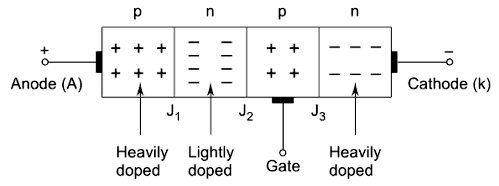If the cathode of the thyristor is made +Ve with respect to the anode & no gate current is applied then:-
Right Answer is:
Only the middle junction is forward biased
SOLUTION
SCR is a unidirectional device and like a diode, it allows current to flow in one direction only. It can be used as a switch. The switching of SCR is controlled by the additional input called the gate and biasing conditions. It can be used as a rectifier to convert AC signals to DC signals.
Construction
The SCR is a four-layer p-n-p-n device, where p and n layers are alternately arranged. The outer layers are heavily doped. There are three p-n junctions called J1, J2, and J3. The outer P-layer is called anode and outer n-layer is called cathode, middle P-layer is called the gate. The terminals are taken out from their layers. The anode must be positive with respect to the cathode so that SCR will be forward-biased. To turn on an SCR, a current is to be passed through the gate terminal. Hence it is a current operated device.

Working of SCR
When the gate is open: Assume that the anode is kept positive with respect to the cathode and the gate is open. Junctions J1 and J3 are forward biased and junction J2 is reverse biased. In J2 a small leakage current flows which is negligibly small. Now the SCR is said to be in off condition. This is called the forward blocking the state of SCR. The voltage applied to anode and cathode is called forward voltage.
⇒ With the gate open, if the cathode is made positive with respect to the anode, the junctions J1 and J3 become reverse biased and J2 forward biased. Still the current flowing is leakage current, which can be neglected as it is very small. The SCR is said to be in a reverse blocking state and the voltage applied is called reverse voltage.
The device behaves as if two diodes are connected in series with the reverse voltage applied across them. Therefore, only a small leakage current (in mA) flows. If the reverse voltage is increased, then at a critical voltage called reverse breakdown voltage VBR, an avalanche will occur at J1 and J3 and the reverse current increases rapidly. A large current associated with VBR gives rise to more losses in the SCR. This may lead to thyristor damage as the junction temperature may exceed its permissible temperature rise. The SCR in reverse blocking may be treated as an open switch because of its offer very high impedance.
